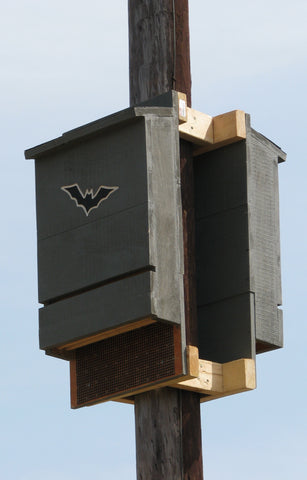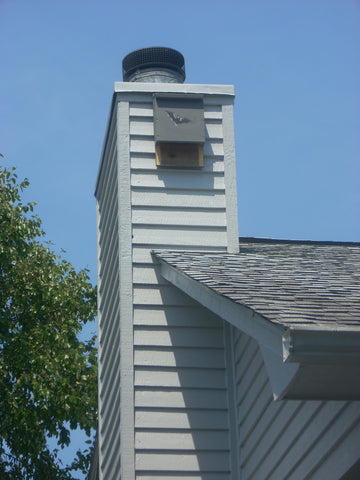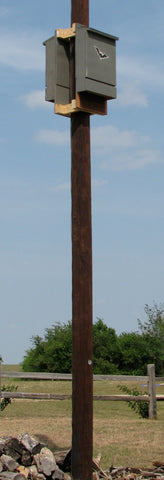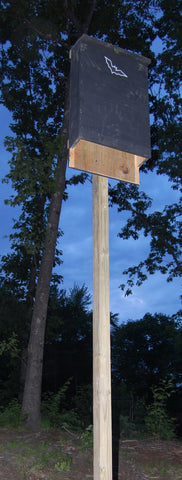Bat House Placement Guide
Bat house placement is the key to attracting bats to your bat house. The following information will help you determine the best location for your bat house.

Image of P&S Country Crafts Bat Houses mounted back-to-back
Mounting on Buildings and Houses
Your bat house can be mounted on the side of a building, barn, shed, or house.
Since bats cannot take flight from a standstill, they need to have around 3 feet of space to drop and catch flight. You'll want to make sure there is ample space surrounding the bat house with few obstacles.
It is recommended that single chamber bat houses be mounted on a building or house, instead of a pole, to help with temperature control.

Image of a P&S Country Crafts Bat House on a house in South Carolina
Mounting on Poles
Mounting a bat house on a pole gives you precision when it comes to ensuring adequate sunlight exposure.
You can use either a wood or steel pole.
When mounting two bat houses back-to-back, you should place one in direct-sunlight and the other bat house mostly in shade. Doing so will provide different temperature options for the bats to choose from, which can increase occupancy.


Images of P&S Country Crafts Bat Houses mounted on poles
Mounting on Trees
Bats are not likely to use bat houses mounted on trees because the branches can obstruct the sun, which is necessary for warmth. However, standing dead trees that receive full sun and are devoid of branches can be appropriate.
Walkways
You should avoid placing the bat house in heavily trafficked areas such as above the front entrance of your home. Noise will not generally bother the bats, however, bats may leave a small amount of bat guano (bat droppings) near the bat house. This isn't harmful, but you probably wont want to keep stepping it. The image below shows you what guano looks like.

Bat guano found underneath a bat house
Height
The bat house should be mounted 12 to 20 feet above ground on either a building/house or a pole.
Predators and Obstacles
You'll want to maintain around 20 feet from the nearest tree branches, wires, and other obstacles.
Bats need ample space to take flight.
Additionally, bat houses with open bottoms do not typically attract predators, but keeping an adequate distance from objects (especially trees) can ensure culprits stay out.
Bat houses with chambers 1.5 inches or larger tend to attract wasps and other animals. All of our bat houses have chambers less than 1 inch.
Temperature and Sun Exposure
Bats typically prefer an internal bat box temperature between 80-100 degrees. You may need to experiment with your bat house placement if you do not see occupancy after a year.
Zone 1: Direct sunlight for 6 to 8 hours.
Zone 2: Direct sunlight for 6 to 8 hours.
Zone 3: Direct sunlight for 6 to 8 hours.
Zone 4: Direct sunlight for 6 hours.

Cleaning and Maintenance
You should not tamper with a bat house when bats are present because it will disturb them and may deter them from returning.
You do not usually need to worry about cleaning the bat house, although you should probably inspect the house once a year to make sure it is properly sealed and there are no pests inside of it.
Although bats will leave droppings (guano), it shouldn't be significant enough to pose a problem, especially when you mount the bat house away from heavily trafficked areas. Guano has actually be known to be a great fertilizer.
When buying a well-constructed bat house, you shouldn't need to worry about resealing edges or repainting for many years. You will know an inspection is due if you see a decline in bats.
Types of Bats
The most common bat species that will live in your bat house is likely the little brown bat (Myotis lucifugus) and the big brown bat (Eptesicus fuscus).
However, there are many different types of bats. See which bats live in your state.
Expectations
Do not be surprised if it takes a bit of time for bats to begin using your bat house.
It is ideal to mount your bat house in early spring following the above guidelines. If after a year you still do not see any bats, you should try relocating the bat house to a place with more or less direct sunlight, as temperature regulation is the biggest cause of failure.
When inspecting the bat house for bats, do not shine lights inside the bat house for longer than a few seconds. Lights can easily irritate the bats causing them to leave. The best way to check if your bat house has occupants is to wait until sunset and see if bats exit the house. Also, bat guano beneath the house is also an indicator of use.
Installation Manuals
[PDF] BCI Bat House Pole Installation Manual
[PDF] PSCC Bat House Building and Pole Installation Manual
